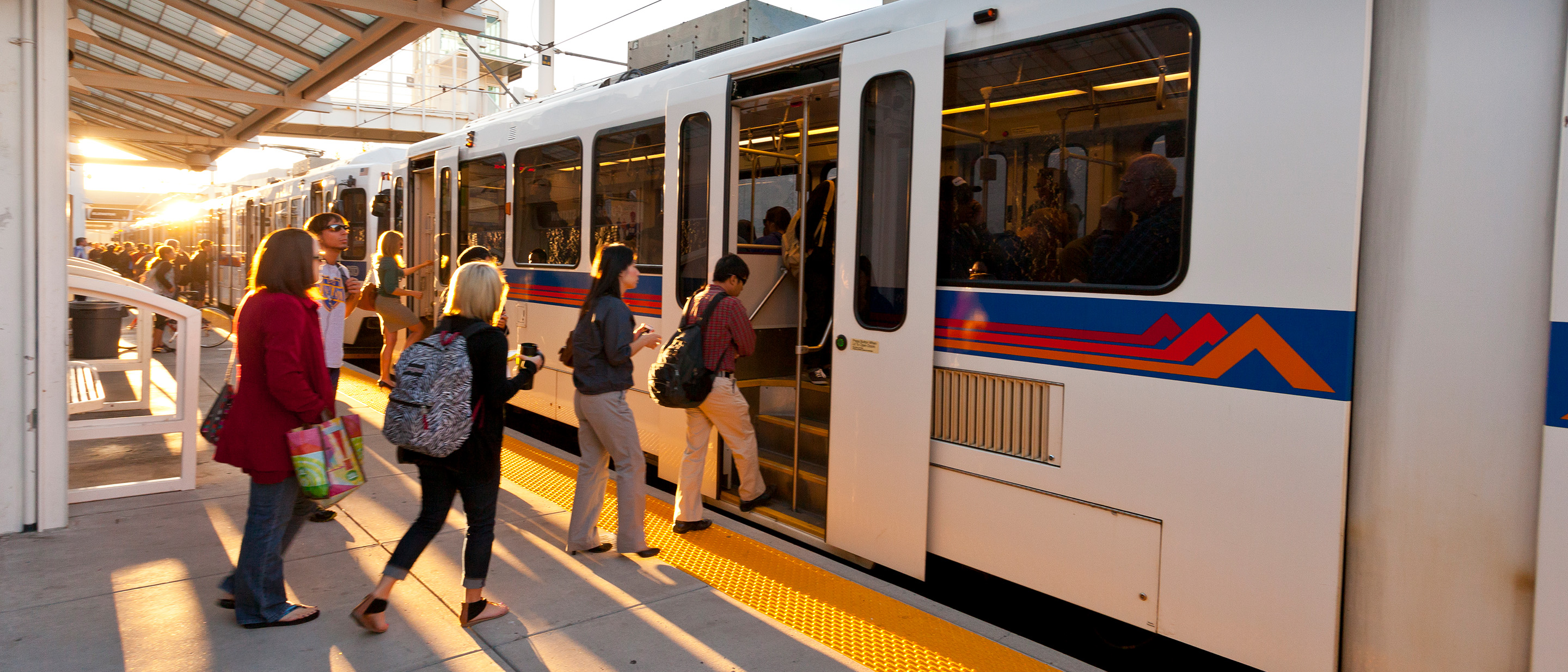
Facts and Figures
The information on this web page is current as of January 31, 2023. The next update to the facts and figures will be made during the first quarter of 2024.
At a Glance
The Regional Transportation District was created in 1969 by the Colorado General Assembly to develop, operate, and maintain a mass transportation system for the benefit of 3.08 million people in RTD's service area. The 2,342 square miles district serves all or part of eight counties:
- Boulder
- Broomfield
- Denver
- Jefferson
- Western Adams
- Western Arapahoe
- Northern Douglas
- Weld
RTD is governed by a 15-member elected Board of Directors, with each district containing approximately 200,000 residents.
Access the latest Board updates here.
Service Overview
- Service Area population: 3.09 million
- Cities and towns served: 40 municipalities in 6 counties plus 2 city/county jurisdictions
- Square miles in service area: 2,342 square miles
- Weekday regular fixed-route scheduled miles: 135,495 (includes bus, rail, Free MallRide, Free MetroRide)
- Annual regular fixed-route service miles operated: 60,532,485 (includes rail)
- Passenger bus stops: 9,720
- Number of fixed routes: 134
- Commuter rail: 4
- Light rail: 6
- Local: 86
- Regional: 11
- Limited: 10
- SkyRide: 3
- Boulder: 13
- Longmont: 4
- Special services: 3 (Access-a-Ride, FlexRide, SeniorRide)
- Partnership routes: 3 (Englewood Shuttle, Anschutz Shuttle, HOP)
Specialized Bus Services
- Access-a-Ride
- FlexRide (23 Service Routes)
- Van Pool (DRCOG Commuter Services)
Active Bus Fleet
- Total buses (all are wheelchair lift-equipped): 1,028
- RTD-owned and operated: 607
- RTD-owned, operated by private carriers: 421
- Peak-hour buses required: 8:08 a.m., 8:41 p.m.
- Average age of fleet: 8.36 years (revenue)
- Annual diesel fuel consumption (RTD-operated buses only): 3,355,843 million gallons
- Access-a-Ride cutaways: 344
- FlexRide cutaways: 58
Rail
Light rail
- Total vehicles: 201
- Miles of track: 60.1
- Stations: 57
Commuter Rail
- Total vehicles: 66
- Miles of track: 54.09
- Active Stations: 27
Ridership
2022
- Annual boardings: 61,602,568
- Bus boardings: 35,479,174
- Access-a-Ride: 529,448
- Rail Boardings: 21,540,452
- Light rail: 13,604,641
- Commuter rail: 7,935,811
2021
- Annual boardings: 49,032,655
- Bus boardings: 28,401,696
- Access-a-Ride: 440,507
- Rail Boardings: 16,601661
- Light rail: 10,016,239
- Commuter rail: 6,585,422
2020
- Annual boardings: 52,616,640
- Bus boardings: 32,932,508
- Access-a-Ride: 332,758
- Rail boardings:
- Light rail: 10,464,678
- Commuter rail: 4,954,167
Financials
Total Operating Budget
- 2022: $770.9 million
- 2021: $629.4 million
- 2020: $739.7 million
Budgeted number of RTD employees
- Salaried: 1,001
- Represented: 2,272
- Total: 3,273
Private Contractor Employees
- Fixed route: 829
- ADA and FlexRide: 586
More Facts and Figures
A LineThe A Line opened on April 22, 2016 and was RTD’s first commuter rail line.B LineThe first segment of the B Line to Westminster opened on July 25, 2016. Clean AirRTD remains an industry leader with the use of alternative fuels and pollution reduction technology.Commuter Rail VehicleRTD’s commuter rail vehicles are heavier and travel faster than light rail vehicles, but operate in a similar way, using overhead electric lines.Downtown Express I-25 HOV LanesThe Downtown Express consists of 6.6 miles of bus/high-occupancy vehicle (HOV) lanes running from downtown Denver to US 36.E, H LinesThe E and H lines opened November 17, 2006 as a part of the Southeast Rail Project. FasTracksFasTracks is RTD's voter-approved transit expansion program -- the largest in the nation -- that is transforming transportation through the Denver metro region.Flatiron FlyerThe Flatiron Flyer, or U.S. 36 bus rapid transit (BRT), is part of RTD’s 2004 voter-approved FasTracks plan to expand transit across the Denver metro region.Free MallRideRTD's Free MallRide connects you to the sights and sounds of downtown Denver. G LineThe G Line opened on April 26, 2019. The 11.2-mile electric commuter rail line connects Denver’s Union Station to northwest Denver, Adams County, and ArvadaL LineIn 2018, the Welton Street segment of the D Line was split off to operate as the L Line between the 18th•Stout Station and the 30th•Downing Station.N LineThe N Line is part of RTD’s 2004 voter-approved FasTracks plan to expand transit across the Denver metro region.R LineThe R Line opened on February 24, 2017 and delivers access to Aurora City Center, Rocky Mountain Regional VA Medical Center, University of Colorado Anschutz Medical Campus, Fitzsimons Life Sciences District, and Denver International Airport via a transfer to the A Line.Union StationDenver’s Union Station is part of RTD’s 2004 voter-approved FasTracks plan to expand transit service across the Denver metro region.W LineThe W Line opened a corridor to the western region on April 26, 2013. The line runs from Union Station to Jefferson County Government Center, with stops along the way in Denver, Lakewood, and Golden.